 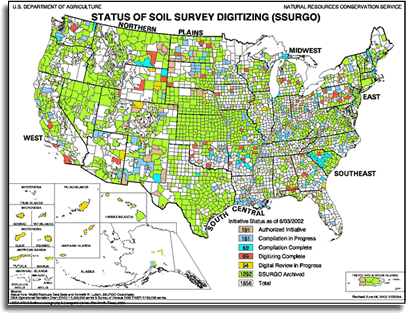 |
||
|
Figure 1. NCGC has long served status maps on the
Internet as static graphics. | ||
Serving USDA NRCS National Geospatial Data Status Information via ArcIMS
Michele Basham May
and J. Steven Nechero
U.S. Department of Agriculture, Natural Resources
Conservation Service
National Cartography and Geospatial Center
Fort
Worth, Texas
The National Cartography and Geospatial Center (NCGC) for the United States Department of Agriculture (USDA), Natural Resources Conservation Service (NRCS) is the technology leader for NRCS cartography, remote sensing, global positioning systems, and geographic information systems. In May 1996, NCGC was designated the clearinghouse for geospatial data for the Agency. As a major distributor of geospatial data to support national, state, and local field needs, providing up-to-date information about the status and availability of various data layers developed, maintained, or distributed by the NRCS is an ongoing challenge. Several status maps, including SSURGO, DOQ, HU, and wetlands easement layers, are now served via ArcIMS using a combination of SDE layers and shapefiles. These maps were formerly provided online as JPG or PDF files. The transition to ArcIMS lead to more highly automated, efficient maintenance processes and provided increased functionality for end-users while affording ArcIMS experience applicable to other projects.
Introduction
The Natural Resources Conservation Service is the branch of the U.S. Department of Agriculture dedicated to conserving soil, water, and other natural resources on America's private lands. NRCS works in partnership with other government agencies and community conservation and agriculture groups. Partnerships with local conservation districts serve almost every county in the Nation, Caribbean area, and Pacific Basin. The technical support provided by the NRCS helps farmers and ranchers manage their land by implementing conservation and agricultural practices suited to their specific needs.
The National Cartography and Geospatial Center is the mapping and spatial data center for the NRCS. As such, the center supports state, field, regional, and national offices with a variety of map products, technical assistance, and leadership in cartography and geographic information systems, remote sensing, global positioning systems, and geospatial database development. NCGC is also the designated An authorized learning center, NCGC has authorized Esri trainers to provide onsite or offsite GIS/GPS instruction. NRCS clearinghouse for geospatial data for the Agency and the center for natural resources inventory data collection and soil survey publication.
Status maps displaying the progress of data collection, updates, or availability for distribution are frequently requested from NCGC. Status maps depicting participation in or results of conservation programs are also popular. These maps are valuable tools, aiding managers in making informed decisions and showing end users at a glance whether the data layers they seek are available.
One of the challenges of serving as a major distributor of geospatial data is that status maps provide only a snapshot in time of information that is quickly outdated. To meet this challenge, NCGC implemented automated procedures for quickly updating the associated databases and generating the maps. Since the mid-1990s, NCGC has published several types of status maps on the Internet, such as soil survey digitizing, national aerial photography flight data, digital orthophoto quarter quadrangle (DOQQ) production, and hydrologic unit (HU) certification, which provide immediate access to current information for managers in disparate locations. Until recently, these maps were only provided for online viewing or printing as static files in one or more image formats (PDF, JPG, RTL) (Figure 1).
  |
||
|
Figure 1. NCGC has long served status maps on the
Internet as static graphics. | ||
In early 2001, NCGC implemented Esri Arc Internet Map Server (IMS) to provide Web-enabled GIS data and services. The ArcIMS projects extend NCGC's ongoing efforts to distribute spatial data and GIS functionality to the field and to facilitate national program management. Although Esri ArcView IMS was implemented in mid-1999 to serve several status maps and other thematic maps, the implementation was not reliable. Existing sites were migrated to a new server running ArcIMS 3.0 upon its release and were subsequently converted to ArcIMS 3.1.
Several national geospatial data status maps - including archived soil survey data, DOQQ and DOQQ county mosaics, Wetland Reserve Program easements, and HU delineation - are now served via ArcIMS using a combination of Esri Spatial Database Engine (SDE) layers and shapefiles. Status maps are now customized and queried using ArcIMS tools presented via a Web browser, providing interactive and more detailed information to the user. These status maps are available from the NCGC Web site at http://www.ftw.nrcs.usda.gov/status_data.html (Figure 2) or at http://lighthouse.nrcs.usda.gov/gateway/gatewayhome.html
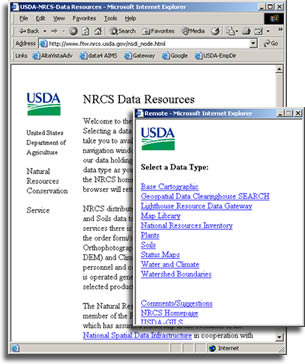 |
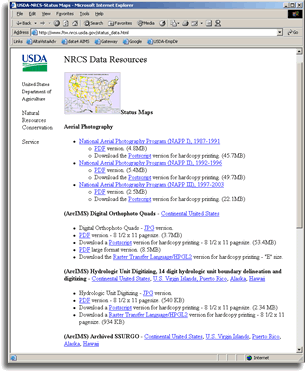 |
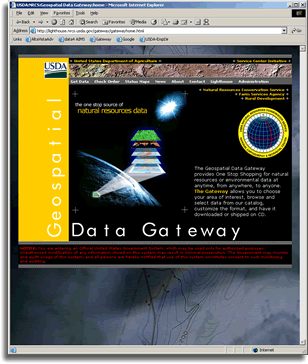 | |
|
Figure 2. Links to Web-enabled status maps are found
on the NCGC Web site and on the USDA NRCS Geospatial Resource Data Gateway.
| |||
Design of the map services and viewers for each status map followed a similar method. In each case the standard HTML viewer was utilized with only minor modifications. Design choices were made based on consideration of necessary functionality, time and complexity of development and maintenance, ease of use, and data retrieval time. A diverse user community with differing levels of GIS familiarity and competency, often with limited access to bandwidth, was also taken into account. Although the Java viewers add functionality, download time for Java components was thought to be high, and installation too cumbersome.
All map configuration files were initially designed using ArcIMS Author, with more complex rendering coded by hand. Data layers (shapefiles and raster data) were added to the map configuration file from a local data source (a hard drive on the server) and from SDE on a Unix server.
Scale-dependent rendering employed on many layers allows them to display only at defined scale ranges and/or changes their symbology or labeling. Minimizing detail at small scales also reduces response time when the user initially loads a map service. Maintaining an appropriate level of detail at various scales also facilitates map navigation. For example, two map services display nationwide roads and hydrography via SDE layers. These large and detailed files are too large to load in a national view; therefore, the user must zoom in to roughly countywide scale before these layers are made visible.
After creating the map configuration file, the map services were published as ImageServices rather than as FeatureServices. Each HTML viewer was then created using ArcIMS Designer, based on the desired functionality for each site. Simple customizations were made to several viewers. These included:
Another important customization included in most HTML viewers involved limiting the attributes displayed when a data layer is queried and assigning aliases to attribute names, thereby removing unnecessary information and specifying meaningful field names.
The ArcIMS 3.1 software is installed on a 733MHz Pentium III Microsoft Windows 2000 server with 512MB RAM with Apache Web server. The database server is a Sun Netra 3000 for Oracle Standard Edition 8.1.6 and Esri Spatial Database Engine (SDE) 8.0.3.
The Wetlands Reserve Program (WRP) provides technical and financial assistance to willing owners of eligible lands to restore, create, protect, or enhance wetlands through permanent or 30-year conservation easements or restoration cost-share agreements to improve migratory bird and wildlife habitat, improve water quality, and aid in flood control and groundwater recharge. Other types of NRCS wetland related easement programs, in addition to WRP, include the Emergency Wetland Reserve Program (EWRP) and the Emergency Watershed Protection-Flood Plain (EWP-FP).
As part of its national program mapping services, NCGC maintains a national layer of wetland easement boundaries. State program coordinators transmit wetland easement shapefiles to NCGC for verification and incorporation into the national layer. A wetland easement boundary status IMS facilitates program coordination, accuracy assessment, and reporting. Geospatial data layers included in this IMS are served via SDE and are updated monthly.
This IMS site - established for agency use only - performs multiple functions for NRCS employees engaged in creating the data layer and for those who need to access information from it (Figure 3). The initial screen provides the progressive, statewide completion status of the wetland easement boundary layer for the 48 contiguous states. A polygon centroid layer shows the actual easement locations to provide users with the extent of the wetland easement occurrence across the nation.
As a user zooms in to view smaller areas, additional data layers become visible when a threshold scale value is passed. Congressional districts are added next. A county boundary layer becomes visible at 1:6,000,000 scale and is then labeled as the scale is further increased. The wetland easement agreement numbers displayed aid in their location although the actual features are so small that they are not discernible at this scale. At a scale of 1:500,000, additional layers become visible, which allow users to view the easement centroids with water bodies, roads, and stream features for reference. Due to their relatively small size - ranging from two to several thousand acres - the actual wetland easement polygons are only added to the map at 1:300,000 scale.
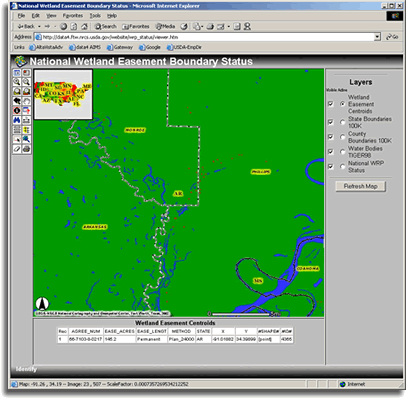 |
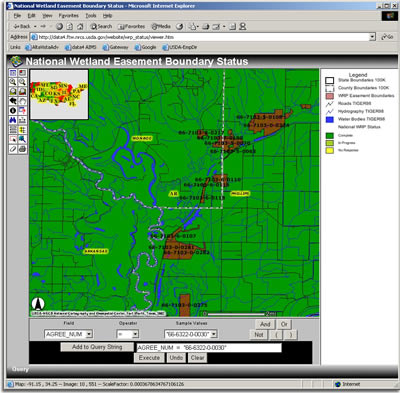 | |
|
Figure 3. The National Wetland Easement Boundary Status
site - available for Agency use only - performs multiple functions for NRCS
employees engaged in creating the data layer and for those who need
to access information from it. Scale-dependent renderers make more detailed
data layers, including the wetland easement polygons, roads, and hydrography
shown above, visible as the user zooms in past scale thresholds.
| ||
The ability to query the attributes of each geospatial data layer greatly increases the functionality of the map service. Users search for a feature in one of the layers to move directly to that feature. Using the WRP example, if a single easement is of interest, the easement layer is queried for the agreement number, and the view is moved to the extent of that feature. Another example would be to view all the WRP easements equal to or greater than 1,000 acres by querying the acres attribute.
The NRCS is responsible for soil survey activities on non-Federal lands. Digitized 1:12,000 to 1:31,680 scale soil survey data are delivered to the public in a Soil Survey Geographic Database (SSURGO), the most detailed level of soil mapping done by NRCS. SSURGO digitizing duplicates the original, printed soil survey maps. This level of mapping is designed for use by landowners, townships, and county natural resource planning and management.
SSURGO data are designed for use in a GIS and consist of map data, attribute data, and metadata. The map extent for a SSURGO data set is a soil survey area, which may consist of a county, multiple counties, or parts of multiple counties. SSURGO data sets are available for selected counties and areas throughout the United States and its territories.
Completed surveys are added to a searchable archive for public downloading via a Federal Geographic Data Committee Clearinghouse or the NRCS Geospatial Resource Data Gateway. NCGC maintains a national map of archived soil survey areas available for downloading. As soil survey areas are completed, their boundaries are manually merged into a national polygon coverage.
An IMS status map covering the continental U.S., Alaska, Hawaii, Puerto Rico, and the Virgin Islands was created to show where archived soil survey areas are available for download (Figure 4). Because the soil survey area boundary coverage may be updated several times per week to reflect newly archived SSURGO datasets, an automated process for updating the IMS was devised.
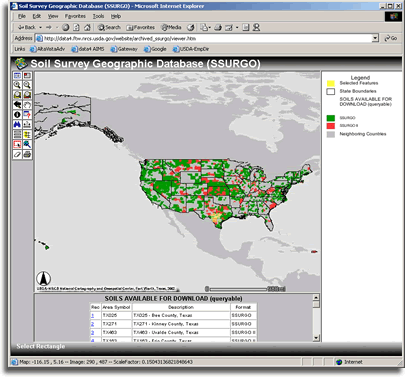 |
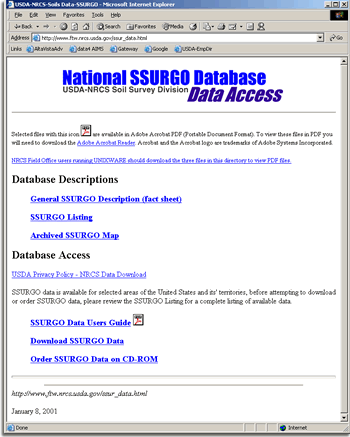 |
|
Figure 4. The SSURGO status map shows where soil survey
areas are available. Archived SSURGO may be downloaded from an NCGC Web
site, shown above right. | |
A batch (cron) job runs a shell script on the Unix SDE server each night to load the soil survey area boundary coverage into SDE. Then a batch file runs under the Windows 2000 server Scheduler, where ArcIMS resides, to refresh the map service. The archived SSURGO layer shown in the map service is actually an SDE view, which is used to select out 'no data' records and reduce query time.
This map service shows available SSURGO areas, along with state and county boundaries, with scale-dependent rendering. The SSURGO layer is classified to depict two versions of SSURGO data because the existing SSURGO dataset is being updated with a new attribute data structure. This map service is also linked to the Geospatial Resource Data Gateway status map list, http://lighthouse.nrcs.usda.gov/gateway/statusmaps.html, again showing what data are available for distribution.
The NRCS employs aerial photographs extensively for a variety of mapping purposes; indeed, digital orthophoto quadrangles (DOQ) are used as the mapping base in most soil survey areas in the United States today. NCGC provides NRCS offices nationwide with DOQ hardcopy base maps, DOQ CD-ROMs, enhanced DOQs, and DOQ compressed county mosaics. Acquired through the USDA Farm Service Agency's Aerial Photography Field Office (FSA-APFO), the USDA Forest Service, the U.S. Geological Survey (USGS), and other sources, NCGC currently maintains almost nationwide DOQQ coverage to facilitate these services.
To maintain a status map of images available in-house, DOQQ mapping uses a coverage created of quarter quadrangles based on the USGS 3.75-minute quadrangle. Updates from USGS for the DOQQ database information are received monthly at NCGC by email. Because images are acquired continuously at NCGC, this database is updated weekly. The DOQQ status data are received as a DBF file and are imported into INFO using AMLs developed at NCGC. The INFO data are then loaded into an Informix database. The DOQQ data in Informix are divided into three tables: quarter quads that are completed, those that are in work, and those that are designated as water. Shapefiles are then created for each of these three layers.
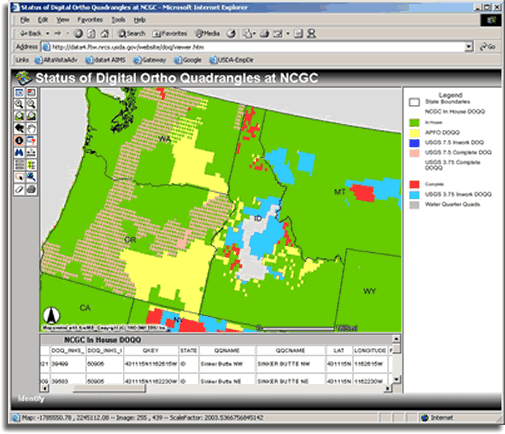 |
|
Figure 5. This ArcIMS site shows the extent and status
of DOQQ imagery at several agencies. |
A status map service using these and other shapefiles shows where quarter quads (and full quads) are available from NCGC, from FSA-APFO, or from USGS (Figure 5). Quarter quads and full quads that are still in work are also shown. Queryable attributes include the quad name, the USGS file name, and the photo date. Base layers in this map service include a labeled quad grid and state and county boundaries for querying. The NCGC layer is updated weekly by a batch job (UNIX cron) that runs an AML to create a set of shapefiles.
IMS As previously mentioned, NCGC houses and distributes DOQ compressed county mosaics produced by FSA-APFO to NRCS offices nationwide. Compressed mosaics are easier to use within an NRCS custom software system used to aid program delivery. NCGC also produces and distributes interim DOQ compressed county mosaics until the APFO-FSA images can be created. All DOQ compressed county mosaics are available by CD-ROM and FTP from the USDA NRCS Geospatial Resource Data Gateway.
An ArcIMS status map showing the source of the mosaic and the type of compression used - either Lizard Tech's MrSID format or Earth Resource Mapping's ERMapper format - is available via a link from the Geospatial Resource Data Gateway status map page at http://lighthouse.nrcs.usda.gov/gateway/statusmaps.html. This map (Figure 6), based on a set of shapefiles, is updated weekly.
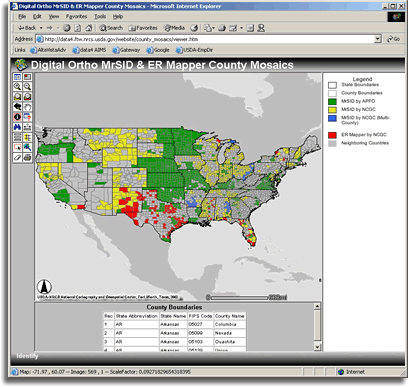 |
|
Figure 6. A Web-enabled map portrays the availability of
DOQQ compressed county mosaics in two compression formats. These mosaics
are in high demand at NRCS field offices because they can be used within
the NRCS Customer Service Toolkit. |
The standardized hydrologic unit code system developed by the USGS in the mid-1970's divides the country into a topographically defined set of drainage areas organized in a nested hierarchy by size. Though extensively used, the standardized 8-digit USGS HUs (Levels 1,2,3 and 4) were too large to use for many NRCS conservation and watershed programs. Beginning in the early 1990's, along with state agency conservation partners, the NRCS began delineating HUs to the fifth (Watershed) and sixth (Subwatershed) level to meet 1:24,000 National Map Accuracy Standards. This initiative developed into a coordinated, interagency effort (Legleiter, 2001).
NCGC maintains standards, guidelines, and quality control for the HU data sets by coordinating and consulting with state office program managers for the review and certification of the data. To facilitate national coordination and reporting, an ArcIMS status map was created.
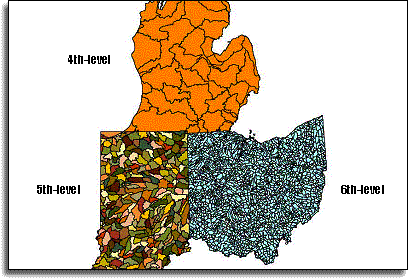 |
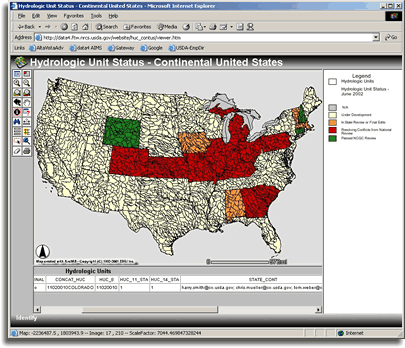 |
|
Figure 7. Hydrologic units, above left, are
being digitized and attributed to the subwatershed level. The ArcIMS map,
upper right, indicates the progress of statewide HU digitization to the
subwatershed level. | |
This status map, updated quarterly, makes attribute data available for the watershed and subwatershed level, along with contact information for each state. The map indicates the progress of statewide HU digitization and attribution to the subwatershed level; the data sets are submitted for verification before inclusion in the national layer (Figure 7). Plans are underway to enable attribute editing via the ArcIMS status map to simplify and expedite progress reporting and data maintenance.
Map services for purposes other than status mapping have also been designed. NCGC developed data and collaborated with the NRCS Information Technology Center (ITC) in Fort Collins, Colorado, to create several Web-enabled GIS pilot sites for New Mexico as part of a telecommunication modernization project.
Approximately 35GB of geospatial data, including imagery, were developed or collected for serving via ArcIMS. Statewide layers served include 1:24,000 scale digital raster graphics (DRGs), soil survey area boundaries, county boundaries, surface ownership, roads, land use/land cover, hydrography, climate, geographic place names, geology, public land survey, and quadrangle indexes. Digital orthophoto mosaics and SSURGO boundaries and interpretations were also served where available.
The New Mexico IMS site currently hosted by ITC is available only within the USDA domain. However, two other pilot sites hosted at NCGC are publicly available. One of these sites displays DRG compressed statewide mosaics at three scales. The initial map displays a 1:250,000 scale DRG mosaic, but zooming in to subsequently larger scales displays in turn 1:100,000 scale and 1:24,000 scale imagery (Figure 8). This site is effective and has even been used in-house for digitizing public land survey data.
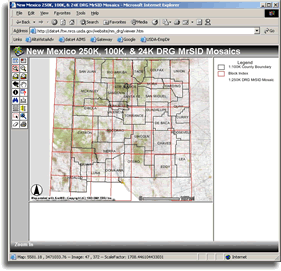 |
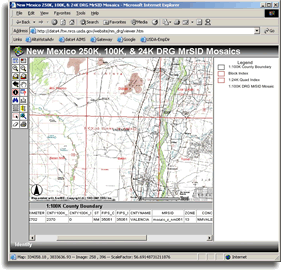 |
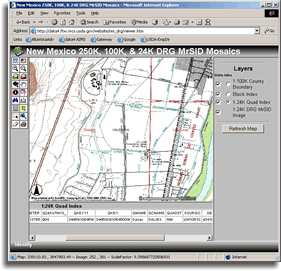 |
|
Figure 8. An ArcIMS site displaying statewide DRG
compressed mosaics at three scales was created for use in New Mexico NRCS
field offices. As a user zooms in, increasingly large-scale imagery is
displayed. | ||
Another New Mexico IMS site requested by the Valencia County field office shows septic tank soil suitability and soil map unit names; it is also accessible via the above URL. For this map service, a soil interpretation was classified to display septic tank absorption field soil ratings ranging from "Not Limited" to "Very Limited." This layer can be toggled on and off to allow display of SSURGO map unit areas. A DOQ compressed county mosaic is also included as a backdrop (Figure 9).
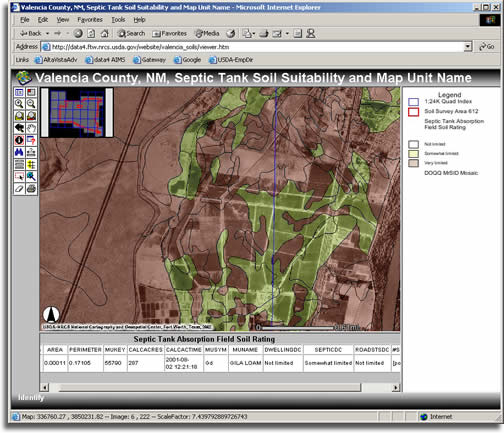 |
|
Figure 9. In this ArcIMS site, soil survey areas are
classified according to their suitability for septic tank use based on
interpreted SSURGO data in Valencia County, New Mexico. The soils data are
draped over a DOQQ compressed county mosaic. The SSURGO map unit names and
symbols can also be displayed by color. |
Each of the IMS sites described above could be further customized to enhance functionality and overall ease-of-use. To improve the performance of some sites, large data layers may need to be generalized. ArcIMS implementation is still relatively new at NCGC, and more experience and experimentation with customization methods, collection of usage and performance statistics, modification of site architecture, and site administration are needed. In some cases additional programming skills must be acquired.
NCGC will continue to leverage its geospatial data warehouses via Web-enabled GIS. Existing sites will soon be converted to ArcIMS 4.0, and new sites to take advantage of the metadata server included with ArcIMS 4.0 are being considered. A pilot initiative has recently been launched to load all DOQ data now stored on CD-ROM to hard disk, and options for serving these data online are being evaluated. As previously mentioned, methods for using FeatureServices to enable attribute editing are also being explored. Finally, a server upgrade is planned as IMS sites are added and usage grows.
Web-enabled GIS provides obvious versatility and functionality not possible with maps posted to the Web as static images. Key features and potential benefits of the interactive status maps described above are multiple:
The transition to ArcIMS status mapping led to more highly automated, efficient maintenance processes and provided increased functionality for end-users while affording ArcIMS experience applicable to other projects. NCGC will continue to leverage is resource data warehouse by distributing GIS capabilities via the Internet.
The authors would like to thank Mary Mattinson, editor, Larry Davis, technical information specialist, Dwain Daniels, soil scientist, Kenny Legleiter, cartographer, and Paul Fukuhara, geodata technology team leader, all at NCGC, for their contributions to and assistance in preparing this paper.
Legleiter, K.J. 2001. Interagency Development of National Watershed and Subwatershed Hydrologic Units. Esri User Conference Proceedings, 21st Annual Esri International User Conference, San Diego, CA.
Michele Basham May
GIS Analyst
/ Cartographer
USDA Natural
Resources Conservation Service
National Cartography & Geospatial
Center
501 W. Felix, Bldg. 23 P.O. Box 6567
Fort Worth, TX
76115
Telephone (817) 509-3459
Fax (817) 509-3469
Email
mmay@ftw.nrcs.usda.gov
J. Steven Nechero
Branch
Leader, Geospatial Data
USDA Natural Resources Conservation
Service
National Cartography & Geospatial Center
501 W. Felix, Bldg. 23 PO Box 6567 Fort Worth, TX 76115
Telephone (817) 509-3366
Fax (817)
509-3469
Email snechero@ftw.nrcs.usda.gov